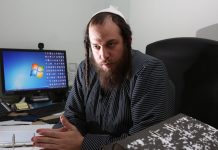At the very edge of the frum part of Flatbush, adjacent to Brooklyn College, lies one of the neighborhood’s not-so-hidden gems: the Pozna shul. This vibrant beis midrash hosts many minyanim, shiurim and kollelim throughout the day. But the true pride of the shul is its steward, Rav Avrohom Eisen, Pozna’s mara d’asra. Ever since joining Reb Avraham Jaffa’s morning kollel in the Pozna shul, I have come to know and admire Rav Eisen. Every morning I watch him make his rounds, asking everyone how they are doing, offering coffee or other refreshments, and doing it all with his inimitable warmth. Rav Eisen makes an immediate impression: tall, with a majestic white beard, he sports a long rekel, biever hit, and most importantly, an ever-present smile radiating from his face. Judging by the reactions in the shul, the rav is well-liked by everyone; it’s apparent that people are immediately drawn to him. His genial personality shines through in every encounter.
Up until recently, I thought of the rav as just that, a chashuve shul rav in Flatbush. Then I saw a picture of him sitting amongst a gathering of gedolim such as Rav Chaim Kanievsky, zt”l, and ybl”c Rav Baruch Mordechai Ezrachi, Rav Dovid Cohen of Chevron, Rav Meilech Biderman, Rav Isamar Garbuz and other Torah luminaries. The caption explained that the occasion was a farher for Shas Yiden, an organization founded by Rav Eisen. I had heard of Shas Yiden before, but I never really looked into it. This picture piqued my curiosity, so I decided to check out what goes into one of their farhers.
At the siyum, a dais with the gedolim was set up on one side facing three rows of yungeleit, each with their own microphone. The tables were beautifully decorated, and in front of each yungerman was a distinctive card announcing the kollel to which he belonged.
“How do you have a case where a korban—?” Even before Rav Baruch Mordechai Ezrachi has finished asking the question, numerous yungeleit are responding, each with a novel approach to answer the gadol’s query. These are not simple talmudic “trivia questions”; all of the gedolim pose difficult and probing questions for these talmidei chachamim, whose knowledge and lomdus clearly astound the interlocutors. Even Rav Baruch Mordechai, who is rarely impressed, shows his amazement and smiles excitedly at the display of geonus from so many yungeleit at once. Every question posed is immediately bombarded by dozens of microphones going off at once, while Rav Eisen sits there shepping nachas from the fruits of his labor.
After witnessing such a singular and dazzling display, I knew I had to speak to Rav Avrohom about the amazing kollel he created.
Rav Avrohom invites me into his office in the Pozna shul, a small room behind the aron kodesh, which he introduces as the Shas Yiden world headquarters. The walls of the narrow room are lined with sefarim shranks all the way to the high ceiling, and in the middle of this humble setting is a small table where we take a seat. Behind the rav is a printer and a little closet where all the Shas Yiden documents are stored. “Yissachar–Zevulun contracts, and other shtaros, “ Rav Avrohom explains.
House of Chesed
“I was born in Yerushalayim,” he begins. “I hail from an old Yerushalmi mishpachah. My grandfather, Rav Shalom, was a noted talmid chacham and posek who was close to all the gedolim. When my father became bar mitzvah, Rav Shalom invited his Rebbe, Rav Isser Zalman Meltzer, to the celebration. My grandfather didn’t expect him to come, but Rav Isser Zalman said, ‘It’s been 13 years since his bris? You just gave me a hirhur teshuvah.’ As hakaros hatov, Rav Isser Zalman shlepped up three flights of stairs to attend the simchah. When my grandfather wasn’t well, he came to the United States for medical treatment and received a visit from Rav Moshe Feinstein, zt”l. He didn’t know Rav Moshe, nor had he ever sent him shailos, so he was curious and asked him why he had come to visit. Rav Moshe responded, ‘Rav Shlomo Zalman Auerbach called and said that there is a sefer Torah [a reference to the grandfather’s Torah knowledge] in the hospital.’ My zaide was Rav Shlomo Zalman’s chavrusa for 48 years,” Rav Avrohom says proudly.
After the Six Day War, Rav Avrohom’s father, Rav Yaakov, made the decision to take his family and immigrate to Canada. “I grew up in Montreal, where my father served as a shochet for many years. Our home was built on chesed. It was an open house, with different guests staying there every day. I often had to ask my mother which bed I was sleeping in that night.”
Rav Avrohom took that ideal of chesed into his own marriage. “I told my wife right away that I always wanted to have guests. A few weeks after we got married, my father and brother stayed with us when they came to New York.” When Rav Avrohom bought his home, he had three bedrooms reserved for guests. “But they weren’t separate from the rest of the house. The upstairs was accessible to everyone. I wanted them to feel at home.”
Rav Avrohom first came to New York to learn in Yeshivas Shaarei Yosher under the tutelage of Rav Yosef Rosenblum. He stayed there until he got married. “Most talmidim went to Lakewood after they got married, but since that wasn’t an option for me, the rosh yeshivah sent me to Yeshivas Mir of Flatbush.” Rav Avrohom went to meet with Rav Shmuel Berenbaum, feeling quite anxious, but Rav Shmuel took one look at the hamlatzah (letter of recommendation) from Rav Rosenblum and accepted him, saying, “This is semichah.”
To read more, subscribe to Ami





















